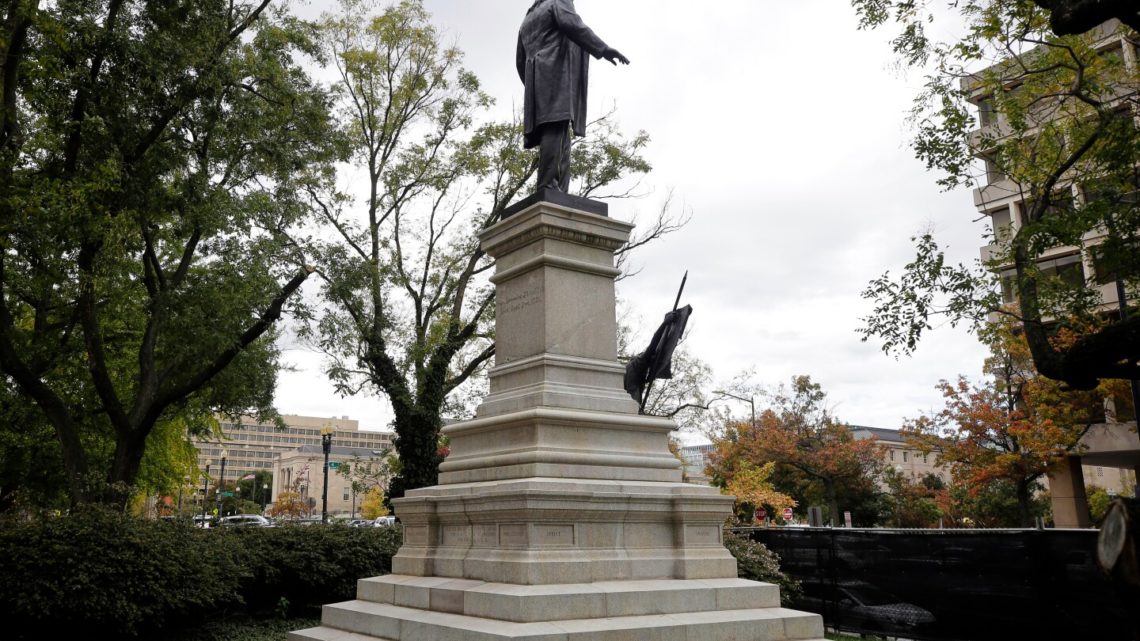WASHINGTON (AP) — The Trump administration has restored a memorial to a Confederate general in Washington, D.C. that demonstrators in the summer of 2020, part of a by the president to reshape the way the country’s history is told.
The statue of Albert Pike, a Confederate general and diplomat who later served on the Arkansas Supreme Court, is the only outdoor statue of a Confederate leader in the nation’s capital. It has been contentious since it was first placed in 1901.
Racial justice protestors in 2020 removed the statue from its pedestal and set it on fire on Juneteenth, a holiday among Black Americans that commemorates the end of slavery. The day was the following year.
The National Park Service in August announced plans to restore the statue in response to a pair of spring executive orders by President Donald Trump about the administration of the nation’s capital and how history is presented.
The administration has already ordered a review of the to align the institution’s content with President Donald Trump’s interpretation of American history. The park service is under orders to review interpretive materials at all its historical properties and remove or alter descriptions that “inappropriately disparage Americans past or living” or otherwise sully the American story.
The statue becomes a political flashpoint
The statue has returned to Judiciary Square, a downtown complex that includes an array of federal and municipal courthouses and the D.C. police headquarters.
Conservatives had seized on the monument’s removal as an example of destructive excess and vandalism by protestors during the summer of 2020. Some rightwing activists praised the statue’s restoration following Trump’s order.
But critics of the monument argue that the public placement of Pike’s statue endorses his views and actions rather than simply commemorates them.
Eleanor Holmes Norton, the city’s lone non-voting elected official in Congress, called the statue’s restoration a “morally objectionable move” in a statement this week. She has proposed legislation in Congress that would permanently remove the memorial.
“Confederate statues should be placed in museums as historical artifacts, not remain in parks or other locations that imply honor. Pike represents the worst of the Confederacy and has no claim to be memorialized in the nation’s capital,” Norton said.
Trump criticized the statue’s removal in 2020 following its removal by protestors, calling it a “beautiful piece of art.”
The removal of memorials to Confederate figures was a key goal of the wave of activism that followed the by a who idolized . More than 480 symbols and statues were removed nationwide since then, according to the Alabama-based Southern Poverty Law Center’s “Whose Heritage?” campaign.
After the 2020 murder of George Floyd by a Minneapolis police officer sparked a nationwide reckoning on racial injustice, the SPLC recorded in that year alone.
Pike statue does not mention his service to the Confederacy
Pike was a slave owner, white supremacist and poet who served as an Army general and diplomat for the Confederate states despite being born and raised in Massachusetts.
During the Civil War, he led Confederate troops in Arkansas and negotiated with slave-owning Native American tribes. Pike received amnesty from President Andrew Johnson in 1865, after which he was accused by former opponents of being involved in the Ku Klux Klan. He moved to Washington in 1870.
Pike’s statue was part of a wave of Confederate statues that were erected across the country, largely in former Confederate states, in the late nineteenth and early twentieth centuries. The statues, often funded and established by Confederate heritage groups, were part of the Southern “Lost Cause” movement that sought to romanticize the Confederacy and downplay the role of slavery as a reason for why states seceded from the Union.
The statue was authorized by Congress in 1898 and then erected in 1901. It was proposed by the Freemasons, who wanted to honor him for his leadership in the society. Union veterans strongly opposed the statue but relented after being assured that Pike would be displayed in civilian clothing. The plaque recognizes Pike as an author, poet and philanthropist but does not mention his military service to the Confederacy.
Northern state lawmakers and Union veterans were outraged by the trend at the time of Pike’s statue being erected and countered the movement by erecting statues of Union generals and lawmakers in cities across the country’s northeast and Midwest.
For instance, the Washington, D.C. neighborhoods of Dupont Circle, Logan Circle and Thomas Circle near the square where Pike’s statue now stands are all named after Union generals.
The post A Confederate statue is restored as part of Trump’s efforts to reshape how history is told appeared first on Associated Press.




